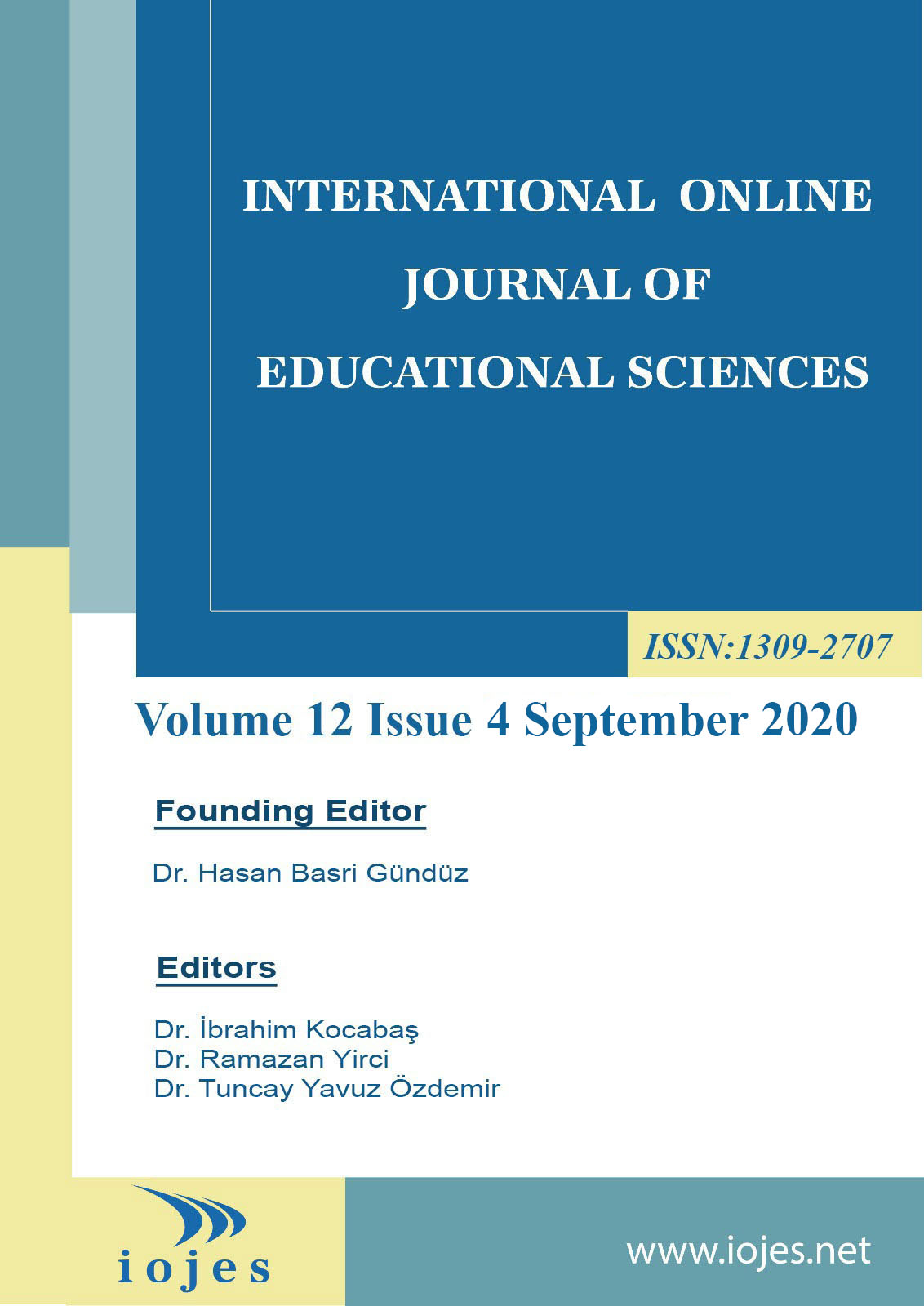Author :
Abstract
Teknolojinin hızlı gelişimi, öğretim yöntem ve tekniklerinin sayısını arttırdığı gibi dil öğretim ve öğrenim süreçlerinde yararlanılan materyalleri de zenginleştirmektedir. Materyaller, öğretici/öğrenicilerin dil öğretimi/öğreniminde her an başvurabilecekleri, süreci destekleyen önemli bir unsur haline gelmiştir. Sözkonusu materyaller arasında filmler de yer almaktadır. Televizyon ve bilgisayarın akıllı telefon adıyla tek makinede toplanabilmesi ve bunlara erişimin giderek kolaylaşması günümüzde, filmleri bir materyal türü olarak dil öğretiminde öne çıkarmaktadır. Filmler öğrenicilere zengin bir öğrenme yaşantısı sunarken, ders iç/dışında da öğrenilenlerin kalıcılığını arttırma ve özellikle hedef dile ait kültür kodlarının aktarılmasında da önemli rol oynamaktadır. Bu araştırmanın amacı, Türkçeyi yabancı dil olarak öğretenlerin bir öğretim materyali olarak filmlerden yararlanma durumlarını ortaya koymaktır. Araştırma, betimsel nitelikte tarama modelinde tasarlanmıştır. Araştırmanın katılımcıları, farklı üniversitelerin Türkçe öğretim merkezlerinde ve Yunus Emre Enstitüsü’ne bağlı birimlerde okutman olarak yurt dışında görev yapan Türkçe öğreticilerinden (n= 107) oluşmaktadır. Araştırmanın uygulamasında öncelikle, ilgili alanyazın taraması sonucu elde edilen bilgilerle anket taslağı oluşturulmuş, alan uzmanlarının görüşlerinin ardından ankete son şekli verilmiştir. Türkçe öğreticilerine dil öğretim süreçlerinde filmlerden yararlanma amaçları ve sıklıkları, ne tür ve hangi filmlerden yararlandıkları, dil öğretiminde filmleri önemli kılan özelliklerin neler olduğu, filmlerden yararlanırken hangi etkinliklere başvurdukları vb. sorular yöneltilmiştir. Elde edilen bulgular bilgisayar ortamında (SPSS 25.0) analiz edilmiş ve araştırmanın sonunda Türkçe öğreticilerine çeşitli önerilerde bulunulmuştur
Keywords
Abstract
Technological advances do not only increase the number of teaching methods and techniques, they also multiply the materials used in language teaching/learning processes. Materials have become an important supporting element teachers/learners can benefit from at any time while teaching/learning a language. These materials do also include films. The fact that television and the functions of computers are nowadays combined in one device called smartphone and the fact that access to them is getting easier from day to day, distinguishes films from other materials used in language teaching. Films do not only offer learners a rich learning experience, but they also improve the learner’s ability to retrieve information in/outside the learning environment and play an important role in transferring the cultural codes of the target language. The aim of the study is to analyse the use of films as educational material by teachers teaching Turkish as a foreign language. The research is based on the descriptive scanning method. The study participants were Turkish teachers (n = 107) teaching at various universities and institutional affiliations of the Yunus Emre Institute abroad. Based on a literature research, the questionnaire used in the study was first drafted and then finalised with the help of experts. The questionnaire aims at determining the objectives, the frequency, the types and kinds of films used in foreign language teaching as well as features that make a film important and activities used along with films. The results were analysed with computer assistance (SPSS 25.0). At the end of the study, teachers were given various suggestions to improve the use of films in Turkish language teaching.
Keywords
- Alvarado, J. L., (2017). Teaching English Using Video Materials: Design and Delivery of a Practical Course. International Journal of Research and Education (IJRE), 2 (3), p. 1-15.
- Arslan, M. & Adem, E. (2010). Yabancılara Türkçe Öğretiminde Görsel ve İşitsel Araçların Etkin Kullanımı. Dil Dergisi, 147, p. 63-86.
- Fauzi, A., Damayanti, D. & Ilahi, T. (2017). A Teacher’s Beliefs on the Integration of Video Technology in Teaching Speaking: A Case Study. International Journal of Pedagogy and Teacher Education, 1 (1), p. 46-54.
- Hung, S. A. (2016). Enhancing Feedback Provision Through Multimodal Video Technology. Computers & Education, 98, p. 90-101.
- Ismaili, M. (2013). The Effectiveness of Using Movies in the EFL Classroom –A Study Conducted at South East European University. Academic Journal of Interdisciplinary Studies, p. 121-132.
- İltar, L. (2019) Dil edinimi, dil öğrenimi/öğretimi ve dil eğitimi üzerine tartışmalar. E. Boylu ve L. İltar (Ed.) Yabancı Dil Olarak Türkçe Öğretimi Politika, Program, Yöntem ve Öğretim içinde. Ankara: Pegem Akademi.
- İşcan, A. (2011). Yabancı Dil Olarak Türkçe Öğretiminde Filmlerin Yeri ve Önemi. Turkish Studies, 6 (3), p. 939-
- İşcan, A. & Karagöz, B. (2016). The Use Of Turkish Films In Teaching Turkish As A Foreign Language: A Sample From Hababam Sınıfı. Participatory Educational Research, IV, p. 190-198.
- Kalenderoğlu, İ. ve Çekici, Y. E. (2017). Yabancı Dil Olarak Türkçe Öğretiminde B2 Düzeyinde Türk Filmleriyle Kültür Aktarımı: Neşeli Günler Örneği. ULUTURKAD, 2 (2), p. 47-57.
- Kalra, R. (2017). The Effectiveness of Using Films in the EFL Classroom: A Case Study Conducted at an International University in Thailand. Arab World English Journal (AWEJ). 8 (3), p. 289-301.
- Karasar, N. (2005). Bilimsel araştırma yöntemleri. Ankara: Nobel Yayınları.
- Kerlinger, F. N. ve Lee, H. B. (1999). Foundations of behavioral research. New York: Harcourt College Publishers.
- Korkmaz, C. B. (2019). Yabancı Dil Olarak Türkçenin Öğretiminde Kullanılan Dinleme Metinlerinin Metin İşleme Süreleri. IJLET, 7 (1), p. 121-146.
- Mustikawati, A. (2013). The effectiveness of using video in teaching speaking for the eighth grade students of SMPN 1 Manisrenggo (Unpublished thesis). Yogyakarta State University, Yogyakarta.
- Octavia, V. S. (2015). The effectiveness of teaching speaking using video narrative to the eight grade students at SMPN 5 Tulungagung in academic year 2014/2015 (Unpublished thesis). Nusantara PGRI University, Kediri.
- Oladunjoye, O. S. (2017). Teaching Vocabulary Using Film and Video: The Development of Senior Secondary Students’ Registers. International Journal of English Language Teaching, 5 (2), p. 83-90.
- Pisarenko, V. (2017). Teaching a Foreign Language Using Videos. MDPI Social Sciences, 6, 125.
- Sherman, J. (2003). Using authentic video in the language classroom. Cambridge: Cambridge University Press.
- Strickland, B., & O’Brien, M. G. (2013). A review of the literature on technology in second and foreign language learning. Retrieved from https://tinyurl.com/yaq7dagt
- Yaylı, D., Yaylı, D. & Ekizler, F. (2013). Yabancı dil öğretiminde filmlerin kullanılması. M. Durmuş ve A. Okur (Ed.), Yabancılara Türkçe Öğretimi El Kitabı içinde. Ankara: Grafiker Yayınları.
- Yılmaz, F. ve Ertürk Şenden, Y. (2015). Yabancılara Türkçe Öğretiminde Kalıp Sözler: “Babam ve Oğlum” Film Örneği. The Journal of Academic Social Science Studies, 32, p. 1870-202.
